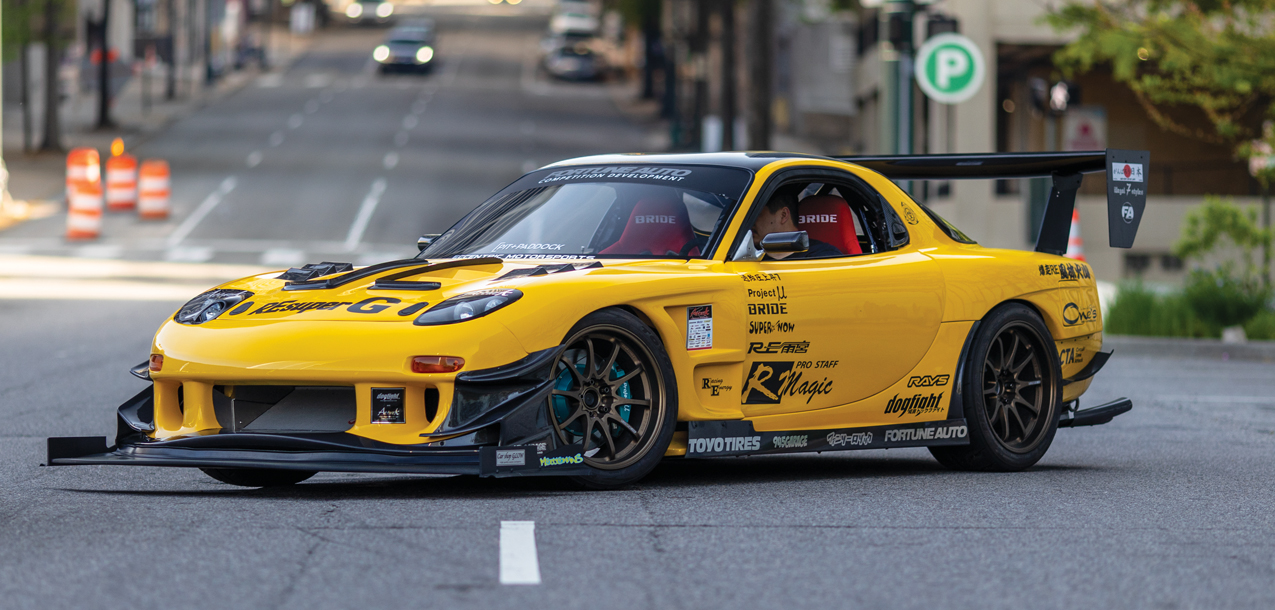DSPORT Issue #249
Text by Arnold Eugenio // Photos by Wayne Hunter
The Wankel engine, or The roTary engine as iT’s informally known received its first engineering patent in the late 1920s, with a working proof of concept appearing some thirty years later. Ten years a er that concept, the engine debuted as a reality in the 1967 Mazda Cosmo and finally found a sporty outfit to wear to the track when the RX-7 debuted in 1978. The RX-7 went on to become the most-popular rotary-powered vehicle in history and helped advance Mazda’s foray into sports car racing and the quest for ever-quickening lap times.
Inspired by the heyday of all things “import sports car” in the late 90s, Chesterfield, Virginia, resident Chris Johnston had longed for the final example of Mazda’s RX-7, the FD3S, since his high-school days. “I had always been fond of the FD platform,” Johnston explains. “The FD was always my go to car in Need for Speed and other games, and of course, Initial D was also a huge inspiration to my love of FDs and my build.” A few months shy of his 16th birthday, Johnston came across a unit and managed to convince his parents that it was the car for him. Some twelve years later, the pinnacle of the car’s career thus far manifested as Johnston’s car was used as a primary display car at the 2021 SEMA show and is now hitting the tracks for some regular assaults on timeslips.
A Brief History of Time
The centerpiece of the Mazda RX-7 universe is the rotary engine. While others have opted to swap out the technology for larger displacement piston engines, Johnston aimed to keep the integrity and spirit of the FD3S alive. “My main goal was to retain the style of the ‘golden age’ of Japanese tuning style,” he relates. “I am not a high-horsepower kind of guy. I opted for a well-balanced car instead. My power goals for the car are whatever it makes at 15psi on pump gas and around 23psi on E85.”
To that end, Johnston relied on Eccentric Motorsports to source a new 13B-REW block upon which to work its magic. A half-bridge port helps increase the pumped air volumes, while the REW rotors and the eccentric shaft are balanced to 10,000 rpm to ensure structural stability throughout the powerband. A er polishing, the rotor housings are held together with a Goopy stud and dowel kit.
Fuel is provided by a pair of Injector Dynamics 1,000 cc/min primary injectors and 2,000 cc/min secondary injectors; the quartet is fed by no less than three Walbro 400 fuel pumps that ensure adequate fuel supply for the ported 13B. The literal spark to get things started is handled by a system of Sakebomb ignition coils sending electrons to a set of MGK spark plugs through MSD cables.
Incoming!
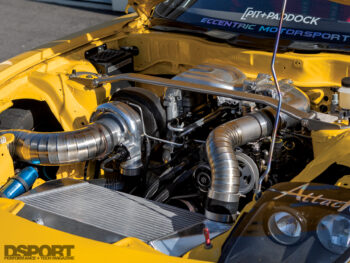
The original equipment boost pressure originated from a pair of sequentially-plumbed turbochargers that were notoriously finicky to modulation and modification. To that end, boost in Johnston’s machine comes from a single BorgWarner EFR 8374 externally wastegated turbocharger coupled with a Turbosmart blowoffvalve. The incoming air charge is first cooled through a PWR intercooler core bookended with custom titanium plumbing fabricated by Eccentric Motorsports. An AEM Methanol injection kit provides additional cooling capability. For the engine’s water-cooling system, Johnston’s RX-7 relies on a custom plumbed and air-ducted PWR radiator core supplemented by a pair of SPAL fans, with water circulated through the system via a Davis Craig electric water pump. Corresponding oil cooling is provided by a pair of Setrab oil coolers, with Eccentric Motorsports custom work finding its way there as well. A Haltech Elite 1500 controls the underhood symphony, under the tuning direction of Ludwig from Eccentric Motorsports.
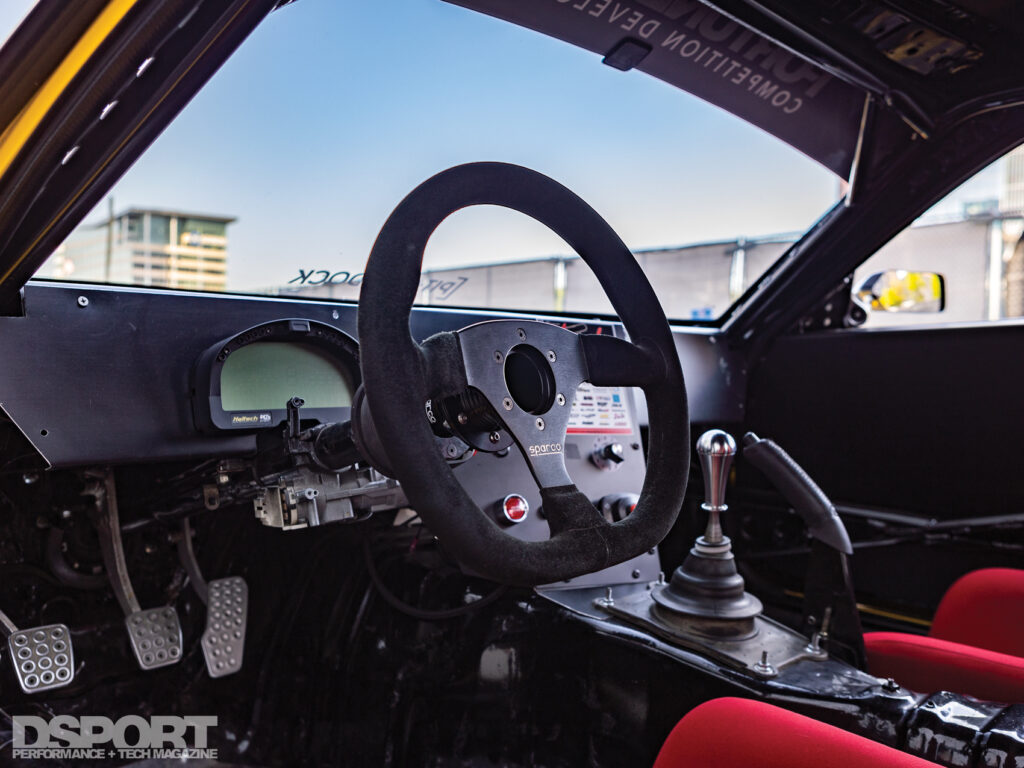
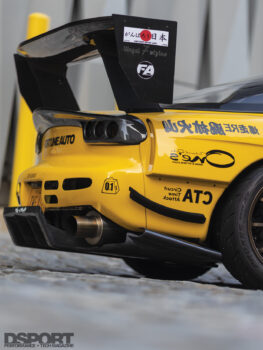
Transmissions to Ground Control
Without the restrictive emissions regulations found Stateside, the Japanese market FD3S transmissions were fitted with gear ratios befitting Mazdas top-of-the-line sports car; Johnston sourced the same for his build but swapped in an RX-8 4.44 final drive. A KAAZ 1.5-way LSD event distributes driveshaft movement, motivated with the aid of an Exedy twin-disk clutch kit and flywheel. Rotational moment translates to forward motion via the 18 x 10.5 in CE28 Club Racer wheels in the rear, with a matching pair of OG CE28Ns in the front; all four are wrapped in 275/35-18 tires of either Toyo R888R or Nitto NT01 vintages.
While the FD3S chassis is considered lightweight from the factory it still requires an effort to slow the mass at racing speeds. To that end, Johnston employs Project Mu 4-piston brakes in the front and Spirit R brakes in the rear. The 355mm front and 314mm rear two-piece Project Mu rotors provide the enlarged surface area for the Project Mu brake pads. A Honed Performance booster delta and Eccentric Motorsports’ ABS delete kit keep the car in race- ready trim, while a larger brake master cylinder sourced from elsewhere in the Mazda family provides the additional pushing power needed to slow the roll.
Safety Word
On the track, driver safety is of the utmost importance. To comply with regulations and keep himself safe, Johnston’s FD is equipped with a 945 Garage ten-point roll cage as the centerpiece. Sitting equipment consists of either Bride Zeta 3 or Recaro SPG seats while Takata six-point harnesses and Sparco steering equipment keep Johnston in place and in control.
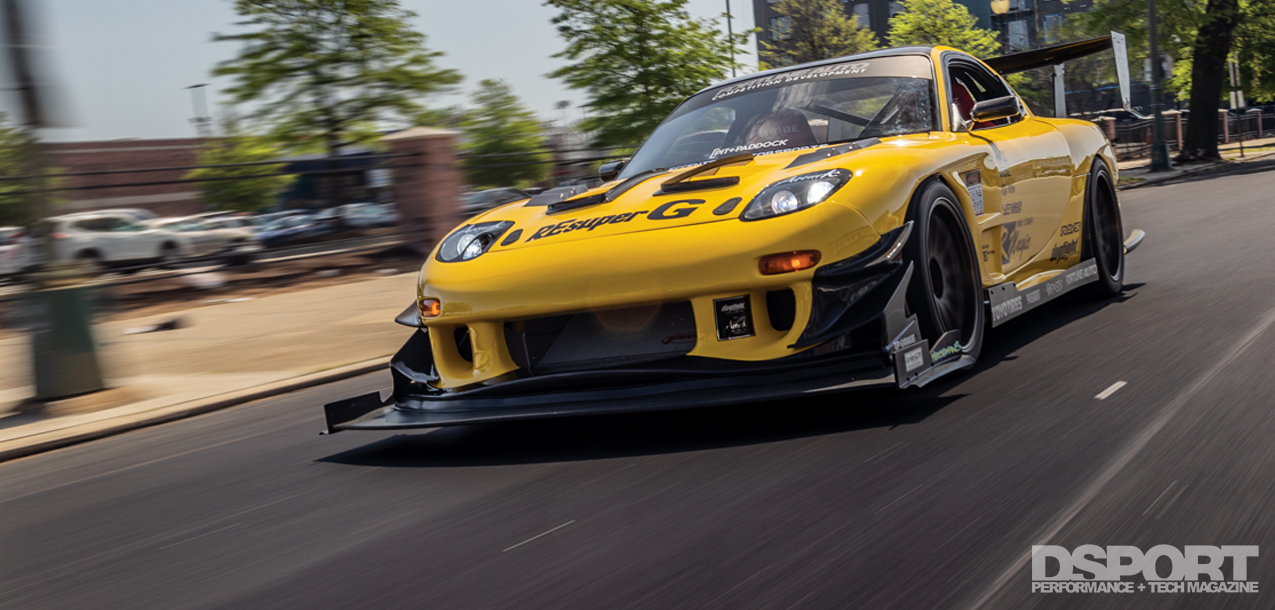
Nineties Rewind
As a product of the 90s import tuning scene, the aero outfitted to the RX-7 isn’t necessarily the latest and greatest but that doesn’t detract from its beauty or its period- correctness. RE Amemiya and R Magic regular and N1 spec components are complemented by Esprit, Seibon and Carshop Glow carbon fiber parts and accessories. The Mazda Sunburst Yellow PPG finish was painted by Johnston himself, an automotive painter by trade.
Back to the Present
As the current iteration of the car was revealed at the 2021 SEMA show, Johnston is just now laying down tracks at circuits in search of the fastest possible lap-time. “I have some things in the works for 2022 and beyond and I’m very excited to see what the future holds,” Johnston explains. As the saying goes, only time will tell, so he’d better start attacking it without further delay.


